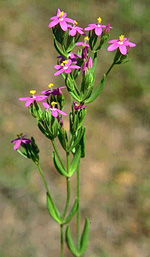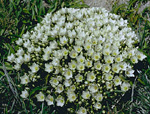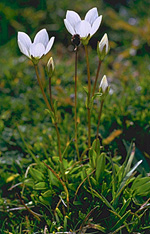 |
This moderate-sized, almost cosmopolitan family is best developed in temperate to cold and alpine regions. Represented in Australia by both native and naturalised species, most species occur in temperate parts of the southern States, although two genera (Canscora and Exacum) are tropical.
Characteristic features of the family in Australia include: - mostly small, glabrous, annual or biennial (rarely perennial) herbs with opposite, entire and usually sessile leaves
- flowers usually white, cream, pink or blue, regular, in terminal, cymose, bracteate inflorescences
- petals and sepals usually 4-5, more or less fused
- ovary superior, developing into a 2-valved, many-seeded capsule
Description
Annual, biennial or perennial terrestrial herbs. Perennating by taproots or crowns. Stem internodes terete or distinctly angular. Internal secretions not obvious. Plants glabrous. Leaves opposite, cauline, all or mostly basal, or both basal and cauline, petiolate, subsessile or sessile. Stipules absent. Lamina simple, symmetric, lanceolate, ovate, elliptic, oblanceolate, obovate or oblong; base cuneate or rounded; margins entire, ±flat; one-veined, or the venation pinnate, or parallel, with the midrib conspicuous or inconspicuous, and the tertiary venation not reticulate; surfaces not punctate; herbaceous. All the flowers bisexual. Inflorescences terminal or axillary, consisting of panicles, corymbs, dichasial or monochasial cymes. Bracts present. Mucilaginous hairs present on buds. Pollination by insects. Flowers odourless or rarely fragrant, stalked or rarely sessile. Floral disc absent; nectaries present on the perianth or the carpels. Perianth regular, of 2 dissimilar whorls. Calyx segments fused, with (4–) 5 (–8) lobes, open in bud; calyx bell-shaped, funnel-shaped or tubular, herbaceous. Corolla segments fused, with (4–) 5 (–8) lobes, alternating with the calyx lobes, imbricate in bud; corolla cup-shaped, bell-shaped or salver-shaped, white, cream, yellow, pink, magenta, purple, violet or blue, without contrasting markings, or streaked, membranous; claws absent; lobes ±entire. Fertile stamens 4–8, opposite to the calyx lobes, at least partly fused to the corolla, free of the ovary and style, distinct from each other, all ±equal. Staminodes present or absent. Anthers dorsifixed or rarely basifixed, versatile or not versatile, opening outwards, sideways, inwards or terminal by pores or by longitudinal slits, 2-celled. Ovary superior and sessile or rarely stalked. Carpels 2, fused; ovary with 1 locule. Style terminal, single and unbranched, single and branched above or from base, or absent and the stigma ±sessile on the ovary. Ovules numerous, sessile; placentation parietal. Fruit a dry, dehiscent, septicidal capsule; the perianth on the maturing fruit dry and persistent. Disseminule micro-surface ±smooth, reticulate, alveolate or rugose, cream, yellow, orange, brown, grey or black, glossy or dull. Aril absent. Cotyledons 2. Embryo straight.
(Note: this description has been generated from the coded data compiled for the key. Any errors in the key data will be reflected in the descriptions.)
A treatment of the family Gentianaceae has been published in:
Flora of Australia 28: 72-104.
Australian genera of Gentianaceae (as recognised for the Flora of Australia)
† = some species native, others introduced
* = all species introduced
*Blackstonia
Canscora
†Centaurium
Chionogentias
*Cicendia
Exacum
Gentiana
Sebaea

|
  |

Centaurium tenuiflorum (flowers)
Photo: G.Leiper © G.Leiper

Chionogentias sp. (flowers)
Photo: M.Plumley © ANBG

Chionogentias muelleriana (flowering plant)
Photo: C.Totterdell © ANBG

Chionogentias muelleriana (flowering plant)
Photo: C.Totterdell © ANBG

|
 |
|